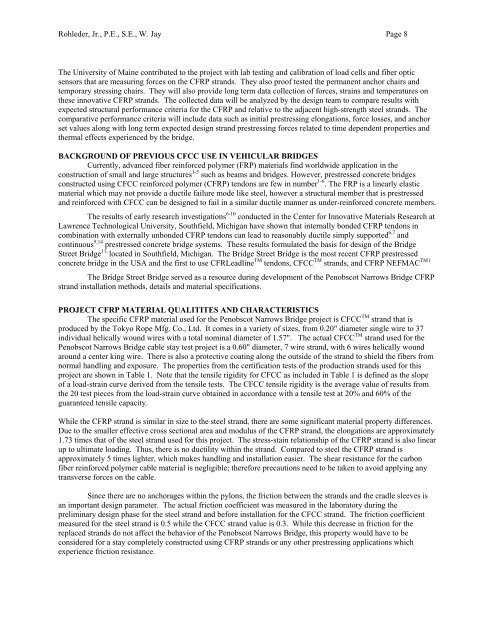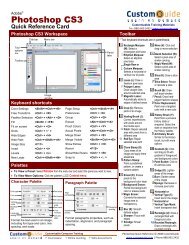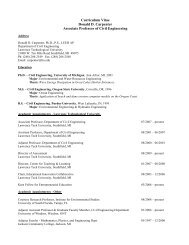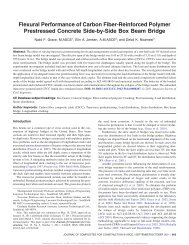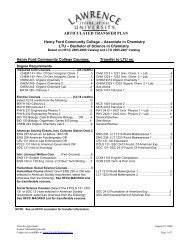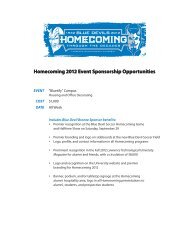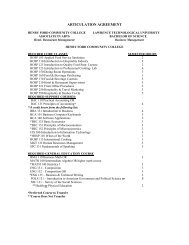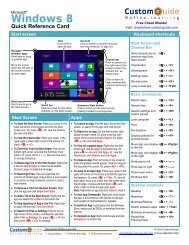CFRP Strand Application on Penobscot Narrows Cable Stayed Bridge
CFRP Strand Application on Penobscot Narrows Cable Stayed Bridge
CFRP Strand Application on Penobscot Narrows Cable Stayed Bridge
Create successful ePaper yourself
Turn your PDF publications into a flip-book with our unique Google optimized e-Paper software.
Rohleder, Jr., P.E., S.E., W. Jay Page 8The University of Maine c<strong>on</strong>tributed to the project with lab testing and calibrati<strong>on</strong> of load cells and fiber opticsensors that are measuring forces <strong>on</strong> the <str<strong>on</strong>g>CFRP</str<strong>on</strong>g> strands. They also proof tested the permanent anchor chairs andtemporary stressing chairs. They will also provide l<strong>on</strong>g term data collecti<strong>on</strong> of forces, strains and temperatures <strong>on</strong>these innovative <str<strong>on</strong>g>CFRP</str<strong>on</strong>g> strands. The collected data will be analyzed by the design team to compare results withexpected structural performance criteria for the <str<strong>on</strong>g>CFRP</str<strong>on</strong>g> and relative to the adjacent high-strength steel strands. Thecomparative performance criteria will include data such as initial prestressing el<strong>on</strong>gati<strong>on</strong>s, force losses, and anchorset values al<strong>on</strong>g with l<strong>on</strong>g term expected design strand prestressing forces related to time dependent properties andthermal effects experienced by the bridge.BACKGROUND OF PREVIOUS CFCC USE IN VEHICULAR BRIDGESCurrently, advanced fiber reinforced polymer (FRP) materials find worldwide applicati<strong>on</strong> in thec<strong>on</strong>structi<strong>on</strong> of small and large structures 1-5 such as beams and bridges. However, prestressed c<strong>on</strong>crete bridgesc<strong>on</strong>structed using CFCC reinforced polymer (<str<strong>on</strong>g>CFRP</str<strong>on</strong>g>) tend<strong>on</strong>s are few in number 1-6 . The FRP is a linearly elasticmaterial which may not provide a ductile failure mode like steel, however a structural member that is prestressedand reinforced with CFCC can be designed to fail in a similar ductile manner as under-reinforced c<strong>on</strong>crete members.The results of early research investigati<strong>on</strong>s 6-10 c<strong>on</strong>ducted in the Center for Innovative Materials Research atLawrence Technological University, Southfield, Michigan have shown that internally b<strong>on</strong>ded <str<strong>on</strong>g>CFRP</str<strong>on</strong>g> tend<strong>on</strong>s incombinati<strong>on</strong> with externally unb<strong>on</strong>ded <str<strong>on</strong>g>CFRP</str<strong>on</strong>g> tend<strong>on</strong>s can lead to reas<strong>on</strong>ably ductile simply supported 6,7 andc<strong>on</strong>tinuous 9,14 prestressed c<strong>on</strong>crete bridge systems. These results formulated the basis for design of the <strong>Bridge</strong>Street <strong>Bridge</strong> 11, located in Southfield, Michigan. The <strong>Bridge</strong> Street <strong>Bridge</strong> is the most recent <str<strong>on</strong>g>CFRP</str<strong>on</strong>g> prestressedc<strong>on</strong>crete bridge in the USA and the first to use CFRLeadline TM tend<strong>on</strong>s, CFCC TM strands, and <str<strong>on</strong>g>CFRP</str<strong>on</strong>g> NEFMAC TM1The <strong>Bridge</strong> Street <strong>Bridge</strong> served as a resource during development of the <strong>Penobscot</strong> <strong>Narrows</strong> <strong>Bridge</strong> <str<strong>on</strong>g>CFRP</str<strong>on</strong>g>strand installati<strong>on</strong> methods, details and material specificati<strong>on</strong>s.PROJECT <str<strong>on</strong>g>CFRP</str<strong>on</strong>g> MATERIAL QUALITITES AND CHARACTERISTICSThe specific <str<strong>on</strong>g>CFRP</str<strong>on</strong>g> material used for the <strong>Penobscot</strong> <strong>Narrows</strong> <strong>Bridge</strong> project is CFCC TM strand that isproduced by the Tokyo Rope Mfg. Co., Ltd. It comes in a variety of sizes, from 0.20" diameter single wire to 37individual helically wound wires with a total nominal diameter of 1.57". The actual CFCC TM strand used for the<strong>Penobscot</strong> <strong>Narrows</strong> <strong>Bridge</strong> cable stay test project is a 0.60" diameter, 7 wire strand, with 6 wires helically woundaround a center king wire. There is also a protective coating al<strong>on</strong>g the outside of the strand to shield the fibers fromnormal handling and exposure. The properties from the certificati<strong>on</strong> tests of the producti<strong>on</strong> strands used for thisproject are shown in Table 1. Note that the tensile rigidity for CFCC as included in Table 1 is defined as the slopeof a load-strain curve derived from the tensile tests. The CFCC tensile rigidity is the average value of results fromthe 20 test pieces from the load-strain curve obtained in accordance with a tensile test at 20% and 60% of theguaranteed tensile capacity.While the <str<strong>on</strong>g>CFRP</str<strong>on</strong>g> strand is similar in size to the steel strand, there are some significant material property differences.Due to the smaller effective cross secti<strong>on</strong>al area and modulus of the <str<strong>on</strong>g>CFRP</str<strong>on</strong>g> strand, the el<strong>on</strong>gati<strong>on</strong>s are approximately1.73 times that of the steel strand used for this project. The stress-stain relati<strong>on</strong>ship of the <str<strong>on</strong>g>CFRP</str<strong>on</strong>g> strand is also linearup to ultimate loading. Thus, there is no ductility within the strand. Compared to steel the <str<strong>on</strong>g>CFRP</str<strong>on</strong>g> strand isapproximately 5 times lighter, which makes handling and installati<strong>on</strong> easier. The shear resistance for the carb<strong>on</strong>fiber reinforced polymer cable material is negligible; therefore precauti<strong>on</strong>s need to be taken to avoid applying anytransverse forces <strong>on</strong> the cable.Since there are no anchorages within the pyl<strong>on</strong>s, the fricti<strong>on</strong> between the strands and the cradle sleeves isan important design parameter. The actual fricti<strong>on</strong> coefficient was measured in the laboratory during thepreliminary design phase for the steel strand and before installati<strong>on</strong> for the CFCC strand. The fricti<strong>on</strong> coefficientmeasured for the steel strand is 0.5 while the CFCC strand value is 0.3. While this decrease in fricti<strong>on</strong> for thereplaced strands do not affect the behavior of the <strong>Penobscot</strong> <strong>Narrows</strong> <strong>Bridge</strong>, this property would have to bec<strong>on</strong>sidered for a stay completely c<strong>on</strong>structed using <str<strong>on</strong>g>CFRP</str<strong>on</strong>g> strands or any other prestressing applicati<strong>on</strong>s whichexperience fricti<strong>on</strong> resistance.


